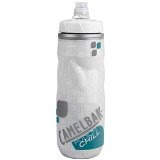(I need to build a special rack for these guys)
For water, I take my Camelbak Podium Chill Water Bottle everywhere. Home, co-working space, working out, trips. Tip of the hat to Donn Felker for doing the leg work on finding this excellent bottle. My only complaint is that it "talks" sometimes. If pressure builds up it will start making noise when it leaks out until you give it a little squeeze.
For coffee this Nissan Leak-Proof Travel Mug has been my goto for about 8 years. I own 3 of them and have bought at least 3 more as gifts. When closed this thing seals like no other. As good for road trips as it is for working around your laptop.
If you don't like the bulky handle, this other Travel Mug from Thermos Nissan is a great alternative recommended by my wife.
For tea, I have my third Thermos Nissan pick, a Tumbler with Infuser. I'm just getting into tea so there are probably some other great options I haven't discovered yet, but I've been really happy with this unit so far.
This summer I got addicted to Starbucks' iced coffee with a shot of white moca. Instead of paying $4 each day I decided to try make my own. First I tracked down the white mocha Starbucks uses. Next, since I use a Keurig for speed and convenience, I went with these Iced Coffee K-Cups. To complete the experience, my wife found these 16oz re-usable Starbucks cups with re-usable straws. To make the drink, put a couple of pumps of white chocolate in first, then fill to pretty much the top with ice, set the Keurig to the 8 oz setting, and brew directly onto the ice. The Iced K-Cups are specially formulated to brew stronger then regular K-Cups, so when the ice melts it balances out. Stir it up to blend in the white chocolate. Then I usually add a few more ice cubes if there is space.






